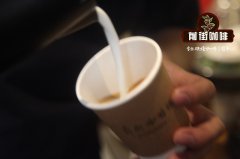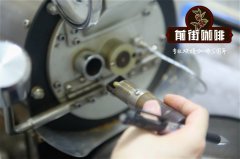Nicaragua Coffee pola Bora producing area Information introduction _ Nicaragua Guapola Coffee beans how to drink

Professional coffee knowledge exchange more coffee bean information please follow the coffee workshop (Wechat official account cafe_style)
Nicaragua is located in central Central America, bounded by Honduras to the north, Costa Rica to the south, the Caribbean Sea to the east and the Pacific Ocean to the west. Managua is the capital of the country. Lake Nicaragua, with an area of 8029 square kilometers, is the largest lake in Central America. Is a magical production of marine fish freshwater lake, pleasant scenery rich Caribbean amorous feelings.
Nicaraguans still maintain the custom of nature worship, adding mysterious meaning to various natural phenomena. Every volcano and lake in its territory has a legend. Momotongbo volcano, located on the north bank of Lake Managua, is famous for its "lighthouse of the Pacific Ocean" when viewed from afar.
Nicaraguan "Paula" is a traditional name, which reflects the folklore and strength of Nicaraguan women. It refers to coffee cultivated in the northern regions of Segovia, Matagalpa and Jinotega. The temperature in this area is 20 Murray 29 degrees Celsius and the average annual rainfall is 1500--1700mm, making it the best condition for coffee production.
Nicaraguan coffee has a wide variety of flavors. Some of the Nicaraguan coffee is reminiscent of Mexican coffee, and some of it is reminiscent of the smell of Guatemala. But what they have in common is that compared with the rich aroma of Nicaraguan coffee, Nicaraguan coffee on the market has been neglected. Some coffee experts highly value that the aroma of Nicaraguan coffee is more textured and uniform than that of coffee in the alpine regions of Central and South America. Generally speaking, high-quality Nicaraguan coffee prides itself on its classical aroma. Recently, there has been a strong trend to use brands from coffee producing areas in various regions for marketing. In the boutique coffee market, Nicaraguan coffee is characterized by nutty and vanilla aromas, complex and soft taste, and appropriate texture.
Baking degree: shallow to moderate baking date: January 25, 2014 bean raising time: 14 days cooking method: siphon after powder pressing hand flushing v60
Brewing Analysis of Nicaraguan Coffee "Paula" Coffee
Recommended cooking methods: siphon, hand flushing
Degree of grinding: 3.5 (Fuji R440, Japan)
V60 filter cup, 15g powder, water temperature 91-92 degrees, grinding 3.5.The ratio of water to powder is close to 1:15
33 grams of water is steamed for 25s
Segment: water injection to 100ml cut off, slow water injection to 225ml
That is, 30-100-95
Other suggestions for trickling extraction:
Normal pressure, recommended grinding degree of 3.5-4 / water temperature 92 °C
Philharmonic pressure, recommended 2.5 grinding degree, water temperature 88 °C
Hand punch: 3.5 degree of grinding, water temperature 89 °C
END
Important Notice :
前街咖啡 FrontStreet Coffee has moved to new addredd:
FrontStreet Coffee Address: 315,Donghua East Road,GuangZhou
Tel:020 38364473
- Prev

Nicaragua Matagalpa Coffee Bean Flavor Description_Matagalpa Coffee Region Information
Professional coffee knowledge exchange More coffee bean information Please pay attention to coffee workshop (Weixin Official Accounts cafe_style) Nicaragua is located in central Central America and is a presidential republic country. Nicaragua borders Honduras to the north, Costa Rica to the south, the Caribbean Sea to the east, and the Pacific Ocean to the west. Managua is the capital of Nicaragua. The climate of Nicaragua is high temperature and rainy in the eastern plains.
- Next

Nicaragua Miyet Ruishou Manor Information introduction _ Nicaraguan Sun Tip Bourbon Coffee good
Professional coffee knowledge exchange more coffee bean information please follow the coffee workshop (Wechat official account cafe_style) # Nicaraguan Coffee-Mierisch Manor Minita sun pointed bourbon natural semi-low-caffeine coffee Nicaragua Mierisch El Minita Laurina Natural # precious variety pointed bourbon (Laurina) Coffee Bean King: bourbon pointed body Bourbon P
Related
- Detailed explanation of Jadeite planting Land in Panamanian Jadeite Manor introduction to the grading system of Jadeite competitive bidding, Red bid, Green bid and Rose Summer
- Story of Coffee planting in Brenka region of Costa Rica Stonehenge Manor anaerobic heavy honey treatment of flavor mouth
- What's on the barrel of Blue Mountain Coffee beans?
- Can American coffee also pull flowers? How to use hot American style to pull out a good-looking pattern?
- Can you make a cold extract with coffee beans? What is the right proportion for cold-extracted coffee formula?
- Indonesian PWN Gold Mandrine Coffee Origin Features Flavor How to Chong? Mandolin coffee is American.
- A brief introduction to the flavor characteristics of Brazilian yellow bourbon coffee beans
- What is the effect of different water quality on the flavor of cold-extracted coffee? What kind of water is best for brewing coffee?
- Why do you think of Rose Summer whenever you mention Panamanian coffee?
- Introduction to the characteristics of authentic blue mountain coffee bean producing areas? What is the CIB Coffee Authority in Jamaica?

